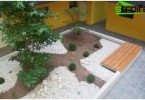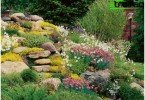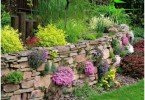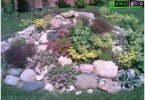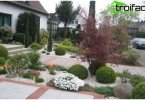Vertical landscaping has come to us since ancient times. As far back as the 9th century BC, the hanging gardens of the Assyrian ruler Semiramis became one of the “seven wonders of the world.” They looked like stepped terraces of vines and climbing roses. Modern gardens are created on the same principle. True, landscape designers of our time are constantly making adjustments and improving the way of landscaping.
Content
- Garden vines
- Container plants
- Sheared trees
Garden vines
With the help of vines, container plants and cut trees in the garden, you can make a very cozy place that resembles a fabulous grove. Green branches weaving along walls and fences significantly enliven the courtyard and make it soulful.
The most plastic of all plants are vines. They adorn not only the country garden, but also large buildings with an asphalt yard. Often even in the city you can find balconies of lower floors, braided with greenery. This creates coziness and comfort inside the apartment and protects residents from the heat in the summer. In the garden, creepers can be planted on any tiers of the site. They can decorate the fence, raise them to a height of up to twenty meters, or, conversely, put on the ground, like a groundcover. Depending on the structure of the support and the relief of the surface, these plants can take the most uncomplicated forms. Therefore, vertical greening of the structure can be done independently, without resorting to designers.
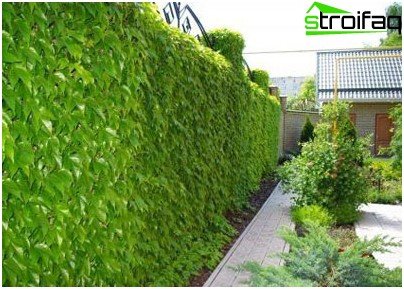
With the help of vines, container plants and cut trees in the garden, you can make a very cozy place that resembles a fabulous grove
Among the varieties of vines are annual and perennial. The latter can be grassy and woody. The stems of herbaceous plants die off in late autumn, and in the spring new shoots are knocked out. Woody stems live for many years, dropping only leaves. Vines grow very intensively, up to 15 cm per day, but they are not able to maintain a vertical position without support because of the lack of thickness of the stems. Caring for vines is simple: they need to be watered on time and the sprouts sent to the right place. When planting, it is advisable to fertilize the soil with humus or other organic substances. If for some reason the earth was not fertilized and the plant is slowly developing, then you can pour it with a solution of nitrate, adding one tablespoon of granules to a bucket of water. The solution must be carefully poured under the root so that it does not fall on the leaves. As fertilizer, you can also use chicken manure, which is the best “food” for any plant. When planting creepers, it must be borne in mind that some of them love the sun, and others like shade or partial shade. For example, fluffy calistegia, golden honeysuckle, honeysuckle, girl’s grapes, bittersweet nightshade and telmana are absolutely unpretentious plants. They can develop in the bright sun and without it. But Chinese lemongrass, Virginian grapes, round-leaved wood-nose pliers, Colomictus actinidia love to grow in partial shade more. If vertical gardening in the garden needs to be carried out in a place where the sun does not fall at all, then plants such as hops, curly aconite and large-leaf aristolochia are suitable.
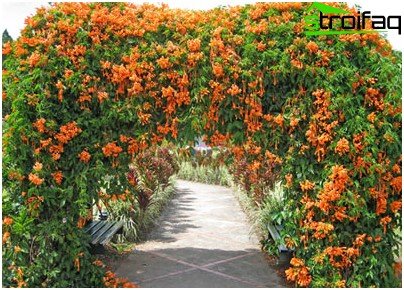
The most plastic of all plants are creepers
Especially relevant are creepers in the garden, where there is no orchard and flower garden. When construction work on the new plot of land is not yet completed, and it is necessary to green the territory, you can start with a hedge. Whatever fence was erected in the country – forged, wooden or stone – creepers will add grace and lightness to it. But perennial plants are better not to plant, they do not grow as fast as annuals. And at the end of the construction your preferences may change, because there will be more time for experiments. Hedgerows are also used to divide the cottages into plots. For example, they separate the garden from the garden, the recreation area from the economic zone. Very often arches and summer cottages for cars are decorated with vines. It is important for each zone to choose the right plant variety, so that the fence looks aesthetically pleasing. Do not try to give preference to expensive large-flowered or velvet vines, such varieties quickly fade. Before choosing plants, you need to consult a specialist, in extreme cases, help to carry out vertical landscaping of photos that can be viewed in magazines and on the network. It is the pictures that will be able to push you to the right thought in the design of your own summer house.
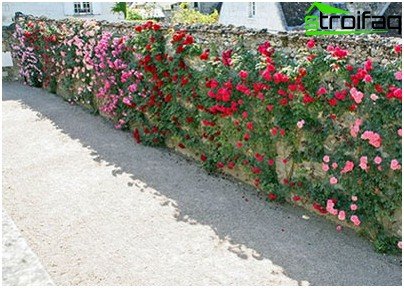
Hedgerows are used to divide the cottages into zones
Container plants
Ampel plants in vertical landscaping occupy not the last place. They are decorated with arbors, window openings, balconies, lampposts, terraces and patios. To do this, use ordinary hanging flowerpots, a cache-pot made of coconut fiber or plastic, and even wooden boxes. Sometimes in the garden they put tall flowerpots in one of the corners, focusing on bright colors. Here the main role is played by human imagination, which cannot be limited. The most common plants for this type of landscaping are fuchsias, petunias, begonias, lobelia, nasturtiums, pelargonium. Along with them, many new varieties of container flowers. These include hybrid forms of petunias, such as caliberhoa, surfinia, fortunia, diasia and tsevola. Increasingly, hanging baskets are decorated with morning glory, cardiosperm, bindweed, quamoclites. Combinations of several types of plants in one flowerpot look very beautiful, only you need to choose the right color: either contrasting colors or close in tone. But it is better to avoid excessive variegation, limit yourself to two or three shades.
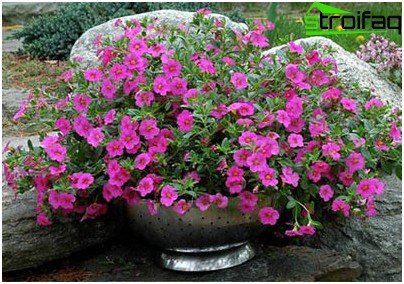
Ampel plants adorn gazebos, patios, balconies and gardens
For container plants, you can use a variety of supports. It can be a low pole stuck in the center of the flowerpot, or it can be figures made of wire. Most often they are made in the form of hearts, rhombuses and balls. On such figures, ivy, loaches and winged tunbergs grow well. Vertical gardening with one’s own hands gives a lot of pleasure, especially when creating different compositions from flowers. But it should be remembered that a container plant will have to develop in a limited amount of soil, so it must be of high quality. It is best to use a moisture-intensive substrate enriched with nutrients.
Sheared trees
In addition to ampelous plants and vines, vertical gardening of walls can be created using hedge fences. They are trees planted in rows, which are attached to supports and purposefully trimmed. The best material for these fences are considered apple trees, pears, willows, elms, buckthorn, hawthorn and raspberry bushes. Limes, maples, mountain ash and some conifers are also widely used. These trees with small leaves make magnificent figures of complex shapes, the so-called topiary haircuts.
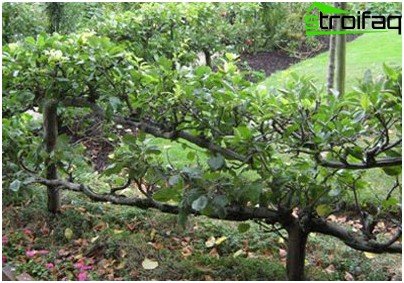
The best material for hedge trimmed trees are apple trees, pears and willows
Topiary art is becoming more and more popular every year, and very often trees are replaced by special frames of various shapes, which are planted with the same vines or other annuals. Such topiaries very quickly produce results that are independent of climatic conditions..
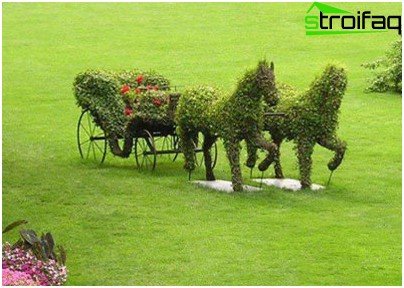
You need to plant plants with love, then your whims of nature will not be afraid of the vagaries of nature
When landscaping your plot, you need to remember that any plants need to be planted with love. Then no whims of nature will be scary to your corner for relaxation. Good luck and creative inspiration.


